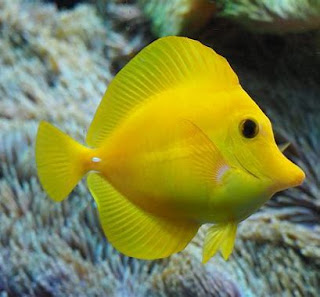Fast Facts: Yellow Tang
The Yellow Tang: Zebrasoma flavescens
Description: The Yellow Tang's bright full-body yellow coloration is what makes distinguishes it from other Tangs. They can grow up to around 8 inches in the wild and have a white barb used for defense and attack on each side of the base of their caudal fin; these barbs are considered to be modified scales of the Tang.
Habitat: A Yellow Tang lives in saltwater reefs all over the world, however, they are most commonly found near Hawaii; about 70% of the Yellow Tang population lives in these waters. This species is native to the Pacific Ocean but may also be found in the Atlantic Ocean.
Diet: As herbivores, Yellow Tangs feed exclusively on plants. Algae is their preferred food source, and Yellow Tangs may even eat the algae off of turtles as part of a symbiotic relationship.
Behavior: Although they do tolerate other individuals given enough space, Yellow Tangs are typically solitary. Mating and breeding season may bring Yellow Tangs together, however, even fertilization of the eggs takes place in the water, outside of the body. After hatching, juveniles may stick together in small groups as a safety mechanism against predators.
Conservation Status: This species is listed as Least Concern. The Yellow Tang has been a part of the pet trade for many years, as its bright colors make it an attractive addition to home aquariums. ICUN records estimate over one million individuals have been collected over the past five years.
Unique Traits: As stated above, algae makes up a significant part of the Yellow Tang's diet, which is important as Yellow Tangs are able to preserve corals that may otherwise suffocate under an abundance of algae and seaweed. By keeping the growth of seaweed in check, Yellow Tangs play a crucial role in maintaining a healthy ecosystem.
An intriguing aspect about the Yellow Tang is its reproductive cycle. These fish are known to spawn only at full moon, and during this time around 20,000 to 40,000 eggs may be produced in one cycle alone, although not all of them will be fertilized.
https://www.reef2reef.com/threads/growth-yellow-tang-in-a-30g.638715/
https://a-z-animals.com/animals/yellow-tang/
https://smartaquariumguide.com/yellow-tang/




Comments
Post a Comment